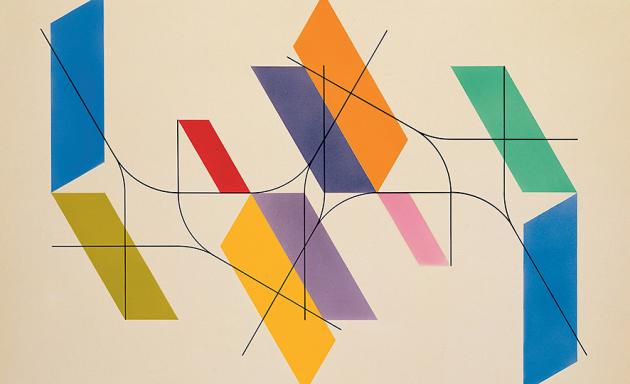Max Bill (Swiss, 1908–1994) artist and designer who founded the Concrete Art movement. His interpretations of Constructivism through painting and sculpture, integrated the study of both geometry and mathematics into his art practice. “I am of the opinion that it is possible to develop an art largely on the basis of mathematical thinking,” Bill once reflected. Born on December 22, 1908 in Winterthur, Switzerland he studied at the Kunstgewerbeschule in Zurich from 1924–1927, then with Wassily Kandinsky and Paul Klee at the Bauhaus school in Dessau for the next two years. Later the co-founder of the Ulm School of Arts and Crafts, he served as the head of architecture and product design there during the 1950s, and later as part of the Swiss Parliament from 1967 to 1971. Bill died on December 9, 1994 in Berlin at the age of 85.Today, he is perhaps best remembered today for his chronoscopes (wrist watches) which are manufactured by the Junghans company in Germany. His works are also held in the collections of a number of institutions, including The Museum of Modern Art in New York, the Art Institute of Chicago, and the National Gallery of Art in Washington, D.C., among others.
Max Bill (Swiss, 1908–1994) was a leader in the Concrete Art movement. In 1924, he trained as a silversmith at the School of Applied Arts in Zurich, but after seeing the work of Le Corbusier, his interests shifted to architecture, and he became a student at the Bauhaus in Dessau. There, he studied under notable artists such as Joseph Albers, Wassily Kandinsky, and Paul Klee. After moving to Zurich in 1929, Bill began pursuing a career as an architect, sculptor, painter, industrial designer, and graphic artist. Inspired by the ideas of Theo van Doesburg, Bill formulated principles of Concrete Art, applying mathematics and geometry to his work.
In 1944, Bill founded the journal Abstrakt Konkret, and, in the 1950s, started writing monographs, catalogues, and journal entries exploring his theories of Abstract Constructivism. Together with Otl Aicher and activist Inge Scholl, Bill founded the Ulm Hochschule für Gestaltung (College of Design), where he became the head of the architecture and Industrial Design departments. Between 1967 and 1974, he taught environmental design at the Hochschule für Bildende Künste (College of Fine Arts) in Hamburg. After joining Allianz (Union of Modern Swiss Artists) in 1941, he founded a publishing company of the same name, and was a member of Abstraction-Création artist association, CIAM (Congrès Internationaux d’Architecture Moderne), Academy for the Arts in Berlin, Bauhaus Archival Association of Berlin, I.C.P. (Institut Für Progressive Kultur), U.A.M. (Union des Artistes Modernes), and various other associations and councils of German and Swiss workers. During his career, Bill was awarded the Grand Prix in both Brazil and Italy. His other achievements include the Award for Art in Zurich and two honorary degrees.
JUNGHANS MAX BILL
Architect of time
Max Bill was an architect, painter, sculptor and product designer. His work was influenced by the Bauhaus philosophy and therefore always reduced to the essentials. His collaboration with Junghans began during his time as rector at the Ulm College of Design (HfG). From 1956 he designed kitchen, table and wall clocks here, which made design history. The logical dial design was also taken up by him in 1961 with the design of wristwatches, which today are considered design icons. Max Bill strived for constructive clarity and precise proportions. Regardless of whether he was dealing with a watch or a work of art, for him both were “shaping the environment” and had to be suitable for everyday use.




